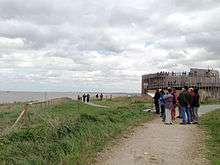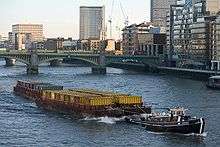Mucking Marshes Landfill


Mucking Marshes Landfill was a major landfill site servicing London, close to the hamlet of Mucking. Covering hundreds of acres of former gravel quarry, it was one of the largest landfills in Western Europe and has been filled for decades with municipal and commercial waste floated thirty miles down the River Thames in barges to Mucking Wharf.[1] The barges, each carrying dozens of distinctive yellow containers, are a familiar, though rarely commented-upon, sight along the Thames through Central London. Once the barges have traveled 30 miles (48 km) downstream from Walbrook Wharf, mechanical cranes at Mucking Wharf unload the containers onto trucks. The trucks make their way up the artificial mound created by decades of garbage compaction that towers over the surrounding flat landscape. Flocks of seagulls and other scavenging estuarine birds are a familiar sight as the trucks disgorge their contents.
The landfill site itself, although it dominates the village of Mucking, is strictly guarded and is surrounded by a perimeter fence more than four miles (6 km) long. Cory Environmental, the operators of the site, have gated off Mucking Wharf Road, meaning that spectacular views of the Thames meeting the North Sea can now be accessed from Mucking only via a circuitous footpath through the neighbouring village of East Tilbury.

In recent years, changes in London governance, including the creation of the Greater London Authority under Ken Livingstone have led to indications of a future reassessment of London's waste strategy based more on recycling and less on landfill sites like Mucking Marshes. In 2007, Mucking Marshes Landfill was granted an extension to receive London's waste until 2010.[2]
In 2012, the site has been reclaimed for community and environmental use in a project involving The Cory Environmental Trust, DP World port, and the Essex Wildlife Trust working together to create the Thurrock Thameside Nature Park. This is a 120-acre (49 ha) wildlife site open to the public, expanding to 845 acres (342 ha) over the next few years, to help establish and protect wildlife and bird populations and environments.[3] The site also houses the recently completed Cory Environmental Trust Visitor Centre, a drum-shaped, timber-clad building designed by van Heyningen and Haward Architects.[4] The reserve and the new building were opened on 11 May 2013 by Sir David Attenborough who described the building as 'revolutionary'.[5]
References
- ↑ Rubbish Please (2015). "Mucking Marshes Landfill". Retrieved 2015-04-08.
- ↑ Essex landfill to take London waste for three more years, www.letsrecycle.com, Retrieved 16 February 2007
- ↑ "Thurrock Thameside Nature Park". Essex Wildlife Trust.
- ↑ "vHH completes another nature reserve scheme". Architect's Journal.
- ↑ "Sir David Attenborough opens landfill site transformed into nature reserve". BBC News.
Coordinates: 51°29′N 0°26′E / 51.49°N 0.43°E
